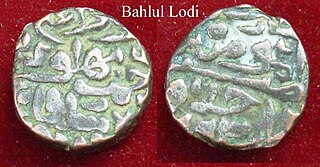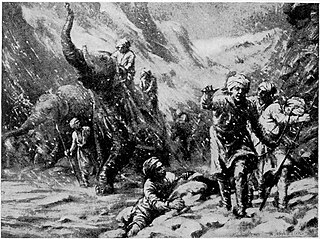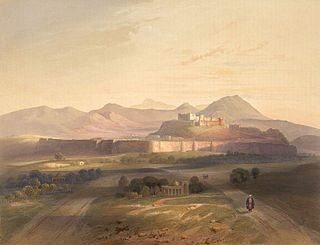Related Research Articles

The Muslim conquests of Afghanistan began during the Muslim conquest of Persia as the Arab Muslims migrated eastwards to Khorasan, Sistan and Transoxiana. Fifteen years after the battle of Nahāvand in 642 AD, they controlled all Sasanian domains except in Afghanistan. Fuller Islamization was not achieved until the period between 10th and 12th centuries under Ghaznavid and Ghurid dynasties who patronized Muslim religious institutions.

Punjab is a geopolitical, cultural, and historical region in South Asia. It is specifically located in the northwestern part of the Indian subcontinent, comprising areas of modern-day eastern-Pakistan and northwestern-India. Punjab's major cities are Lahore, Faisalabad, Rawalpindi, Gujranwala, Multan, Ludhiana, Amritsar, Sialkot, Chandigarh, Shimla, Jalandhar, Patiala, Gurugram, and Bahawalpur.

Multan is a city in Punjab, Pakistan, located on the bank of Chenab River. Multan is one of the five largest urban centres of Pakistan in 2024 and is the major cultural, religious and economic centre of Southern Punjab. Multan is known for its rich ancient heritage and historic landmarks. The city is one of the oldest inhabited cities of Asia, with a history stretching deep into antiquity. A historic capital of Punjab and a significant cultural centre of Indus Valley civilization. Multan region was centre of many civilizations in its 5 millennia old history.

The History of Punjab refers to the past history of Punjab region which is a geopolitical, cultural, and historical region in the northwest of South Asia, comprising western Punjab province in Pakistan and eastern Punjab state in India. It is believed that the earliest evidence of human habitation in Punjab traces to the Soan valley of the Pothohar, between the Indus and the Jhelum rivers, where Soanian culture developed between 774,000 BC and 11,700 BC. This period goes back to the first interglacial period in the second Ice Age, from which remnants of stone and flint tools have been found.

Abu Mansur Nasir al-Din Sabuktigin, also spelled as Sabuktagin, Sabuktakin, Sebüktegin and Sebük Tigin, was the founder of the Ghaznavid dynasty, ruling from 977 AD to 997 AD. In Turkic the name means beloved prince.

Abu al-Qasim Mahmud ibn Sabuktigin, usually known as Mahmud of Ghazni or Mahmud Ghaznavi, was Sultan of the Ghaznavid Empire, ruling from 998 to 1030. During his reign and in medieval sources, he is usually known by his honorific Yamin al-Dawla. At the time of his death, his kingdom had been transformed into an extensive military empire, which extended from northwestern Iran proper to the Punjab in the Indian subcontinent, Khwarazm in Transoxiana, and Makran.

Bahlul Khan Lodi was the chief of the Afghan Lodi tribe. Founder of the Lodi dynasty from the Delhi Sultanate upon the abdication of the last claimant from the previous Sayyid rule. Bahlul became sultan of the dynasty on 19 April 1451.

Jayapala was a ruler of the Hindu Shahi dynasty from 964 to 1001 CE. He ruled over the area which stretched from Laghman in the west, to Kashmir in the east and from Sirhind to Multan. He was the son of Hutpal and the father of Anandapala. Epithets from the Bari Kot inscriptions record his full title as "Parama Bhattaraka Maharajadhiraja Sri Jayapaladeva".
The recorded history of Lahore, the second largest city-district of Pakistan, covers thousands of years. Lahore is regarded as the post medieval or modern day capital and largest city of the Punjab region, it has since its creation changed hands from Ghaznavid, Hindu, Buddhist, Greek, Muslim, Mughal, Ghorid, Maratha, Sikh and the British, thereby becoming the cultural capital and the heart of modern-day Pakistan.
Abu Ali Lawik of the Lawik dynasty was the son of Abu Bakr Lawik, and also a brother-in-law of the Hindu Shahi ruler of the region, Kabul Shah. He was invited by the people of Ghazni to overthrow Böritigin or Pirai and proceeded in alliance with the Shahi Rulers of the region in this venture.
'Yamini Turks had claimed their descent from Shahyar, the last of the Parthian ruler who was killed in 637AD in the battle of Cadesia. The family had migrated to Turkistan and after three generations had passed on as Turks. Their founder Sabuktgin had come into the service of Alptgin, a Samanid governor of Turkistan. The latter had captured Ghazni and settled there in 963AD. He raised Sabuktigin to the position of a general. After the death of Alptgin in 966 AD, Balktgin the commander of Turkish troops succeeded him who was later succeeded by Pirai a slave. The latter was a cruel king and the people of Zabul invited Abu Ali Lawik son of the last ruler of Zabul who in alliance with the Shahis of Udabhanda marched to recover Ghazni. On the way at Charkh, Sabuktgin defeated them and became a hero.
Multan in Punjab province of Pakistan is one of the oldest cities in South Asia, though its exact age has yet to be determined. Multan remained the capital of Punjab region in bulk of the later ancient and most of the medieval era. Multan region was centre of many civilizations in its history, and witnessed warfare across millennia because of its location on a major invasion route between South and Central Asia. Multan reached the height of its splendour during the Arab rule of 9th and 10th century when it was made a separate state, the Emirate of Multan, as it controlled large parts of Punjab and Kashmir. It is famous for its Sufi shrines. Multan province was one of the largest and first-established provinces of the Mughal Empire.
The Hindu Shahis were a dynasty that held sway over the Kabulistan, Gandhara and western Punjab during the early medieval period in the Indian subcontinent, replacing the earlier Turk Shahis. They were ultimately conquered by Ghaznavid Empire in a series of wars in the early 11th century.
Sajāwand is a village in Baraki Barak district, Logar province, Afghanistan.
The Lodi dynasty was the last dynasty to rule over Emirate of Multan, from their capital city of Multan in the 10th century.

The Lawīk dynasty was the last native dynasty which ruled Ghazni prior to the Ghaznavid conquest in the present-day Afghanistan. Lawiks were originally Hindus, but later became Muslims. They were closely related to the Hindu Shahis, and after 877, ruled under the Hindu Shahi suzerainty.

Emirate of Multan was a medieval Muslim kingdom in Punjab that was centred around city of Multan, present-day part of Punjab, Pakistan. It was initially ruled by the tribe of Banu Munabbih. In 959 CE, Ismaili Qarmatians under Banu Lawi gained control of the Emirate and in 1010, it was conquered by Ghaznavid Empire.

The Second Battle of Laghman was fought between the Ghaznavid forces under Sabuktigin and the Hindu Shahi under Jayapala near Laghman in 991 AD. It took place near Laghman, present day Afghanistan.

The First Battle of Laghman was fought near Laghman in present-day Afghanistan, between the Ghaznavid empire under Sabuktigin and the Hindu Shahis under Jayapala in 988 CE. The Ghaznavids defeated the Hindu Shahis and Jayapala signed a treaty in which the Hindu Shahis paid tribute to Ghaznavids.

The Ghaznavid campaigns in India refer to a series of military expeditions lasting 54 years (973–1027) launched by the Ghaznavid Empire, a prominent empire of the 10th and 11th centuries, into the Indian subcontinent, led primarily by Sultan Mahmud of Ghazni, leaving a profound impact on the region's history and culture.

The Ghaznavid invasion of Kannauj or the siege of Kannauj in 1018 was a military campaign conducted by Mahmud of Ghazni, the then ruler of the Ghaznavid Empire, against the Gurjara-Pratihara dynasty. During this siege, the Gurjar ruler, Rajyapala, eventually surrendered to Mahmud of Ghazni, thereby accepting nominal suzerainty under his rule. This event marked the decline of the Gurjara dynasty's power. In the aftermath of his surrender to Mahmud, Rajyapala met his demise at the hands of the Chandela ruler, Vidhyadara, for capitulating to the Ghaznavid conqueror.
References
- ↑ Yogendra Mishra (1972). The Hindu Sahis of Afghanistan and the Punjab, A.D. 865-1026: A Phase of Islamic Advance Into India. Vaishali Bhavan. pp. 100–101.
- ↑ Samuel Miklos Stern (October 1949). "Ismā'ili Rule and Propaganda in Sīnd". Islamic Culture. Islamic Culture Board. 23: 303.
- ↑ Yogendra Mishra (1972). The Hindu Sahis of Afghanistan and the Punjab, A.D. 865-1026: A Phase of Islamic Advance Into India. Vaishali Bhavan. pp. 100–103.
- ↑ N. A. Baloch; A. Q. Rafiqi (1998). "The regions of Sind, Baluchistan, Multan and Kashmir". History of Civilizations of Central Asia, Volume 4. UNESCO. pp. 297–298. ISBN 9789231034671.